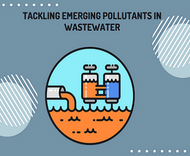Contaminant Removal: Tackling Emerging Pollutants in Wastewater
Posted by David Cannon on 11th Jul 2023

In recent years, the presence of emerging pollutants in wastewater has become a growing concern due to their potential impact on human health and the environment. Emerging pollutants, also referred to as trace organic contaminants, encompass a diverse range of chemicals, including pharmaceuticals, personal care products, flame retardants, and endocrine disrupting compounds. These substances are not typically regulated and monitored in wastewater treatment processes, making their removal a significant challenge.
The entry of emerging pollutants into wastewater can occur through various sources, such as residential, industrial, and agricultural activities, as well as improper disposal practices. Once these pollutants enter the wastewater stream, conventional treatment methods may not be effective in completely removing them. Therefore, it is essential to explore innovative technologies and strategies that can target and eliminate these contaminants and improve the efficiency of the wastewater treatment plant.
Impact on Human Health:
The presence of emerging pollutants in wastewater poses potential risks to human health. Certain pharmaceuticals, and personal care products, when consumed or absorbed by humans, can have adverse effects. For example, the long term exposure to antibiotics and hormones present in wastewater can contribute to the development of antibiotic resistance and disrupt the endocrine system.
Moreover, the incomplete removal of emerging pollutants from wastewater can result in their persistence in the environment and potential exposure through drinking water sources. This exposure may lead to detrimental health effects, that includes reproductive disorders, developmental issues, and increased cancer risk. As, it is crucial to prioritize the removal of emerging pollutants to safeguard public health.
Impact on the Environment:
The impact of emerging pollutants on the environment is significant, particularly on aquatic ecosystems. When wastewater containing these contaminants and toxic chemicals that is discharged into water bodies, it can disrupt the natural balance which will affect various organisms in the ecosystem.
Endocrine disrupting compounds, such as bisphenol A (BPA) and phthalates, can interfere with the hormone systems of aquatic organisms, leading to reproductive abnormalities, impaired growth, and population decline. Pharmaceuticals and personal care products can also accumulate in the tissues of fish and other aquatic organisms, potentially causing toxicity that altering the ecological dynamics of aquatic communities.
Furthermore, the persistence and bioaccumulation of emerging pollutants can have cascading effects on the food chain. Predatory species that consume contaminated prey may experience biomagnification, where the concentration of pollutants increases as it moves up the food chain. This phenomenon can lead to higher levels of contamination in organisms at the top of the food chain, including humans who consume contaminated seafood.
Innovative Technologies for Contaminant Removal
- Advanced Oxidation Processes (AOPs):Advanced Oxidation Processes involve the generation of highly reactive hydroxyl radicals to break down complex organic compounds into simpler, less harmful substances. AOPs include methods such as ozone treatment, UV irradiation, and the combination of both (UV/H2O2). Ozone treatment can effectively degrade various emerging pollutants, while UV irradiation can target compounds that are resistant to conventional treatment methods. The synergistic combination of UV and hydrogen peroxide enhances the degradation efficiency of certain contaminants.
- Activated Carbon Adsorption: Activated carbon is a highly porous material that has a strong affinity for organic contaminants. It can effectively adsorb a wide range of emerging pollutants, including pharmaceuticals, pesticides and personal care products. The adsorption process occurs when contaminants in the wastewater come into contact with the activated carbon surface and adhere to it. Activated carbon adsorption is widely used in water treatment plants and can be employed as a standalone treatment or as a polishing step in combination with other processes.
- Membrane Filtration: Membrane filtration techniques, such as reverse osmosis (RO) and nanofiltration (NF),provide effective removal of emerging pollutants by physically separating them from the water. These processes use semi-permeable membranes with tiny pores that allow water molecules to pass through while rejecting contaminants based on size and charge. Reverse osmosis is particularly effective in removing a wide range of contaminants, including pharmaceuticals, endocrine disruptors, and organic chemicals. However, it is energy-intensive and generates a concentrated waste stream that requires proper disposal.
- Biological Treatment: Biological treatment methods utilize microorganisms to degrade and remove emerging pollutants from wastewater. One common approach is the activated sludge process, which involves the use of microorganisms in an aerobic environment to break down organic compounds. Another method is constructed wetlands, where naturally occurring microorganisms in the wetland soil and plants contribute to the degradation of pollutants. Biological treatment offers an eco-friendly and cost-effective solution, as it harnesses the natural processes of microbial metabolism to remove contaminants.
- Advanced Membrane Technologies: Advancements in membrane technologies have led to the development of novel approaches for contaminant removal. For example, forward osmosis (FO) and membrane distillation (MD) utilize osmotic pressure and temperature gradients, respectively, to separate contaminants from water. These technologies show promise in removing emerging pollutants and reducing energy consumption compared to traditional membrane processes.
Conclusion
Tackling emerging pollutants in wastewater requires a comprehensive & multidisciplinary approach. The implementation of advanced oxidation processes, activated carbon adsorption, membrane filtration, biological treatment methods, etc... Along with the support of companies like Cannon Water Technology, can significantly contribute to the removal of emerging pollutants and mitigate their potential impact on human health and the environment. As we continue to advance in research and technology, it is crucial to prioritize the development and implementation of efficient and sustainable solutions to address the challenges posed by emerging pollutants in wastewater industry.
